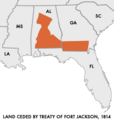Treaty of Fort Jackson facts for kids
The Treaty of Fort Jackson was an important agreement signed on August 9, 1814. It took place at Fort Jackson near Wetumpka, Alabama. This treaty happened right after the United States and their allies defeated the Red Sticks. The Red Sticks were a group of Upper Creek people.
The big battle that led to this treaty was called the Battle of Horseshoe Bend. It was fought near the Tallapoosa River in what is now Alexander City, Alabama. General Andrew Jackson led the U.S. forces. His army included soldiers from the West Tennessee Militia and the 39th United States Infantry. They also had help from several groups of Cherokee and Lower Creek people who were friendly with the Americans.
The Red Sticks were led by Chief Menawa. After their defeat, many survivors, including Menawa, went to Florida. There, they joined forces with the Seminole people. The signing of this treaty officially ended the Creek War. This war was happening at the same time as the War of 1812 between the United States and Great Britain.
One of the most important parts of the treaty was that the Creek people had to give up a huge amount of their land. They gave about 23 million acres to the United States government. This land included their remaining territory in Georgia and a large part of central Alabama.
This major victory helped General Jackson move on to Louisiana. There, he defeated British forces in the Battle of New Orleans. His wins against Native American groups and then against the British made him very popular. This popularity helped him become president in the 1828 presidential election.
Contents
What Was in the Treaty?
The Treaty of Fort Jackson was a formal agreement between General Andrew Jackson, representing the United States, and the leaders of the Creek Nation. It was signed on August 9, 1814.
Why Was the Treaty Made?
The treaty stated that the Red Sticks had started a war against the United States. It mentioned that the U.S. had won this war fairly. Before the war, there had been attacks on U.S. citizens and friendly Creek people. These attacks happened in places like Fort Mimms. The treaty also said that many Creek leaders had been influenced by people they called "Prophets" and by foreign agents. These people encouraged them to break earlier peace agreements.
What Did the United States Demand?
The United States made several demands in the treaty:
- Land Cession: The U.S. demanded a large amount of land from the Creek Nation. This land was to cover the costs of the war. The exact borders of this land were carefully described. However, some friendly Creek leaders who fought with the U.S. were allowed to keep a square mile of land for their homes. They and their families could stay there as long as they lived on the land.
- Guaranteed Territory: The U.S. promised to protect the remaining land of the Creek Nation that was not given away.
- No Foreign Contact: The Creek Nation had to stop all communication and trade with British or Spanish forts, towns, or agents. They could only trade with people approved by the U.S. President.
- Military Posts and Roads: The U.S. demanded the right to build military forts and trading posts on Creek land. They also wanted to build roads and have free use of all the rivers and waterways.
- Return of Property and People: The Creek Nation had to immediately return any people or property they had taken from U.S. citizens or friendly Native American groups. In return, the U.S. promised to give back property taken from the Red Sticks after they surrendered. They also promised to return any prisoners taken during the war.
- Surrender of Leaders: The U.S. demanded that the Creek Nation capture and hand over any "Prophets" or people who started the war. This applied to anyone who had not surrendered to the U.S. forces.
Help for the Creek Nation
The treaty also included a promise from the United States to help the Creek Nation. Since the war had left them very poor and without food, the U.S. agreed to provide them with food and other basic needs. This help would continue until the Creek people could grow enough crops to feed themselves. The U.S. also planned to set up trading posts to help the Creek Nation get clothing through hard work and saving money.
Lasting Peace
Finally, the treaty stated that a lasting peace would begin from that day forward. This peace would be between the Creek Nation and the United States, as well as with the Cherokee, Chickasaw, and Choctaw nations.
Who Signed the Treaty?
Many important people signed the Treaty of Fort Jackson.
United States Signatory
- Andrew Jackson, Major General commanding the Seventh Military District
Creek Nation Signatories
The treaty was signed by many Creek chiefs and warriors, representing different parts of the Creek Nation. Some of the notable signers included:
- Tustunnuggee Thlucco, Speaker for the Upper Creek
- Micco Aupoegau, of Toukaubatchee
- Tustunnuggee Hopoiee, Speaker of the Lower Creeks
- Micco Achulee, of Cowetau
- William McIntosh, Jr., a major from Cowetau
- Tuskee Eneah, of Cussetau
- Noble Kinnard, of Hitchetee
- Timpoeechee Barnard, Captain of the Uchees
- Yoholo Micco, of Kialijee
- Efau Haujo, of Puccan Tallahassee
- Nomatlee Emautla, or Captain Issacs, of Cousoudee
- Tuskegee Emautla, or John Carr, of Tuskegee
Witnesses
Several people witnessed the signing of the treaty, including:
- Charles Cassedy, acting secretary
- Benjamin Hawkins, agent for Indian affairs
- Return J. Meigs, Agent of Creek nation
- Robert Butler, Adjutant General U. S. Army
- J. C. Warren, assistant agent for Indian Affairs
- George Mayfield, Alexander Curnels, George Lovett, Public interpreters.
Images for kids
See also
 In Spanish: Tratado del Fuerte Jackson para niños
In Spanish: Tratado del Fuerte Jackson para niños



